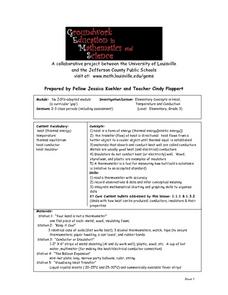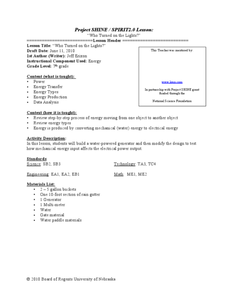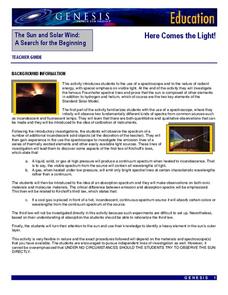Colorado State University
If Hot Air Rises, Why Is it Cold in the Mountains?
Investigate the relationship between temperature and pressure. Learners change the pressure of a sample of air and monitor its temperature. They learn that as air decreases its pressure, its thermal energy converts to kinetic energy.
Chicago Botanic Garden
Albedo, Reflectivity, and Absorption
What is reflectivity, and what does it have to do with the Earth's climate? As reflectivity is measured by albedo, scientists can gather information on Earth's energy balances that relate to global warming or climate change. Budding...
It's About Time
What Drives the Plates?
It's getting hot in here! Lead your emerging geoscientists on a thrilling journey as they calculate liquid densities to determine forces that stimulate thermal plates from within the earth's crust. They explore effects of temperature on...
Curated OER
Elementary Concepts in Heat
Third graders read a thermometer with accuracy, record observations and data, and infer conceptual meaning. They integrate mathematical charting and graphing skills to organize their data. They explore what happens when they touch or use...
Curated OER
Insulators, Conductors, and Energy Transfer
Third graders conduct experiments to determine what types of material make good insulators. They prepare a graph of time vs. temperature for their sample. They choose a graph using each kind of material to display for class analysis and...
Curated OER
An Introduction to Thermal Spray Technology
Students discuss difference between kinetic and thermal energy, develop and demonstrate understanding of key concepts and characteristics underlying thermal spray techniques, list items used in their daily lives that are coated, examine...
Curated OER
Thermal Energy Transfer - Conduction
Students examine how heat passes through a pane glass window. In this energy transfer lesson students complete a lab activity.
Curated OER
What's Cooking
Students complete a solar radiation activity. In this solar radiation lesson plan, students complete an experiment to learn about solar radiation. Students make solar tea by using the energy of the Sun to brew tea.
Curated OER
Survival Still
High schoolers explain how to desalinate water using solar energy. In this solar lesson students complete a lab activity and explain capillary water.
Curated OER
Who Turned on the Lights?
Seventh graders discuss how energy is transformed from one form to another. In this physics lesson, 7th graders design and build their own hydro generator. They identify the factors that affect its energy production.
Curated OER
Solar Power
Students discover how engineers use solar energy to heat buildings. They investigate the thermal properties of different materials. They evaluate the usefulness of each material.
Curated OER
The Urban Heat Island Effect - Lesson 2 (Grades 8-9)
Students use the scientific process to show that when various surfaces are exposed to similar environmental conditions, surface temperatures may vary. They examine the "urban heat island" phenomenon and analyze why it increases energy...
Curated OER
Example of Convection
Compare the density of different salt solutions and then observe currents that are caused by the difference. Set up a demonstration of dynamic equilibrium. The intent with these activities is to begin building understanding of density...
Curated OER
Endothermic or Exothermic That Is the Question
Students conduct an experiment to determine what happens to heat energy during a chemical reaction. They examine an endothermic reaction by observing a chemical reactions.
Curated OER
Solar
Students study solar energy. In this renewable energy instructional activity students complete several lab activities using different controls and variables.
Curated OER
Sand or Rock? Finding Out From 1,000 km
Students observe how measurements are made with different instruments. For this remote sensing lesson students investigate the physical state of surfaces including the surfaces of the solar system.
Colorado State University
What Is Beyond the Rainbow?
Help your classes see what they cannot see. Using different eyewear, scholars experience different light spectrums. Learners may be surprised by how the world looks with infrared light, thermal imaging, and ultraviolet light.
Colorado State University
What Is a "Model"?
Model the transfer of energy during a typical 24-hour period. Young scholars use a game-like approach to learning the patterns of heat transfer through the day and night. Groups of four exchange different tokens as the energy transfers...
Colorado State University
What Makes a Gas, a Greenhouse Gas?—The Carbon Dioxide Dance
Investigate a heated topic in environmental science. Scholars team up to play the parts of gas molecules in the atmosphere. As the teacher moves about, acting as the electromagnetic wave, learners react as their molecules would to the...
Colorado State University
How Can Clouds Keep the Air Warmer?
Condensing water warms the air around it. Young scholars consider this concept as they experiment with air temperature around evaporating and condensing water vapor. They simulate the formation of clouds to experience the associated...
Colorado State University
Do Cities Affect the Weather? (Making a Cloud in a Bottle)
The dynamics of a city can have a drastic effect on the weather. A hands-on lesson asks learners to build a model to illustrate how city pollution provides a nucleus for condensation. The greater the pollution, the greater chance for...
Colorado State University
What Is a "Convection Cell"?
Round and round in circles it goes! A hands-on activity has learners recreate a model of a convection cell. They watch as the difference in density of their materials creates a current.
NASA
Here Comes the Light!
Look beyond the light! An engaging activity introduces young scholars to the application of a spectroscope. The activity is the fifth in a series of six and focuses on the analysis of the elements of the sun.

























